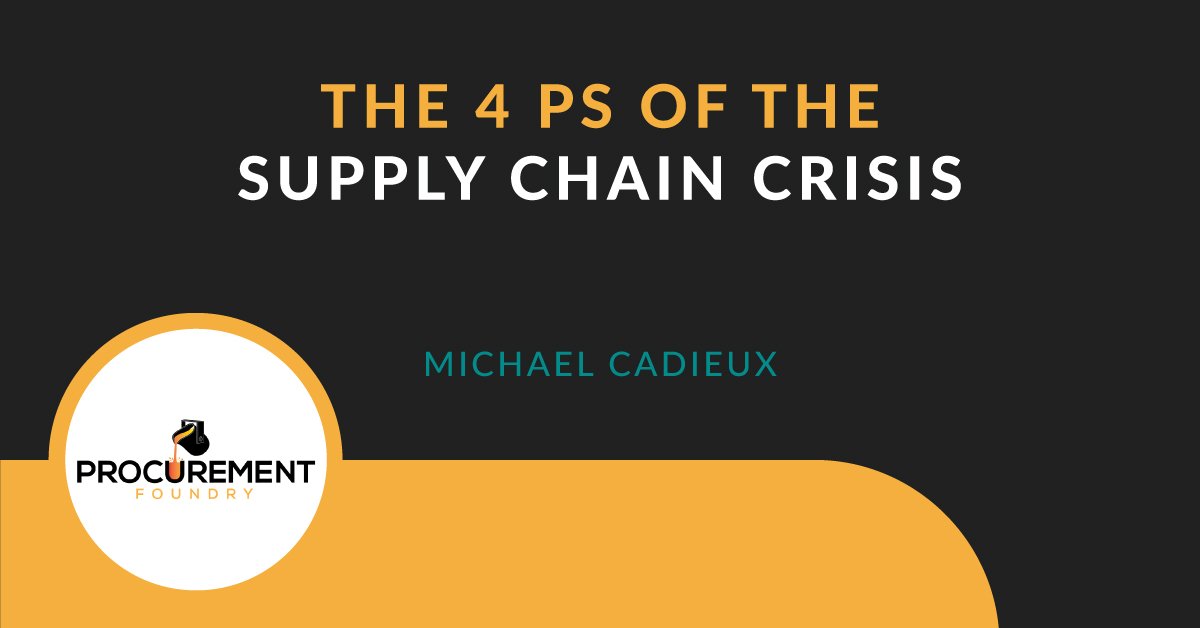Maximizing Savings Opportunities and Procurement's Strategic Value for CPOs
Saving money is not always about pinching pennies: advanced and data-driven insights enable you to identify real cost-saving opportunities, negotiate...

It’s no secret that the procurement industry has found itself in a bind of late—thanks (or no thanks) to supply chain disruptions and a pandemic-induced spike in worldwide demand. As production struggles to pick up the pace that has suffered due to countless shutdowns, many are left to wonder: How did we arrive at the current supply chain crisis?
To answer that question, as well as to explain where we can go from here, Sridhar Tayur, professor of operations management at Carnegie Mellon University’s Tepper School of Business, used what he termed the “The Four Ps of the Supply Chain Crisis.” The Four Ps are Product, Prices, People, and Politics. Now, let’s take a closer look at how procurement’s Ps played a role in getting to where we are now.
Huge labor shortages are cropping up, with the workforce (people) being lost for many reasons. Some workers are getting caught in the crossfire of rising product costs and not paid what they’re worth due to companies tightening the purse strings. This tightening has inevitably resulted in what you could call justified wage rage, and ultimately, a labor shortage due to either workers quitting to pursue new (and better) opportunities or companies being forced to lay off employees to trim the fat.
Also attributing to the labor shortage is the lack of STEM skilled workers, which has been an issue for a while and will continue to be in 2022. This labor shortage is understandably having a direct impact on supply chain and procurement departments, with production levels dropping drastically due to decreased workforce, among other issues.
Rising costs and inflation are plaguing nearly every industry, and procurement bears the brunt of the burden. Among the most costly of supplies are raw materials, and many companies have already been—and are likely to continue—passing some of these high costs on to their customers. The harsh reality is that inflation seems here to stay rather than a passing plight.
As mentioned above, there have been labor shortages across the supply chain, making it even more difficult to get specific products. Demand is high across the board, but there is a particular surge in demand for semiconductors, which are some of the hottest—and hardest to come by—commodities these days. As a result, items requiring semiconductors as components for functionality and operation also face a severe shortage.
There is no denying that politics holds much power in the industry, and we have seen firsthand how a massive influx of political decisions has made a direct impact on today’s current state of affairs. Think about it: Politics is the governmental hand that rocks the cradle and holds immense sway that affects numerous constantly moving parts. And as we move forward in 2022, more sweeping mandates, inflation, multi-national trade policies, and immigration (to fill high skill and low skill positions) will continue to be politically-touched tenets that will have a big impact on how things pan out.
Once a popular logistic model, the Just in Time Model (JIT) operates on the premise of moving materials just before they’re needed during the manufacturing process. This approach reduces the need for storing (or stockpiling) an excessive amount of extra materials in a warehouse.
The ultimate aim of JIT is to only have the materials you need on hand at each moment (no more, no less) to streamline processes, reduce storage costs, and more. While JIT models used to be huge moneymakers, they simply no longer work (look at what happened amid COVID, where many companies were rubbing their temples while wishing they’d stored some sort of safety stock).
So, the next question is: If JITs are out, what’s next? We think that the shocking—and impossible to predict—demand brought on by pandemic supply shortages will lead many to return to the old days, where ordering a little extra safety stock is worth a bit of additional inventory cost. After all, if history repeats itself, you’ll be glad you were prepared. We also predict strengthening strategic partnerships with suppliers will make its way to the tip-top of companies’ to-do lists in 2022.
While we have seen how The Four Ps have brought us “here,” it is important to understand that all hope is not lost, and we can learn so much from 2021 as we face forward in 2022.

Saving money is not always about pinching pennies: advanced and data-driven insights enable you to identify real cost-saving opportunities, negotiate...

The topic of our recent roundtable discussion with a dozen Procurement Foundry community members—exploring potential flaws in procurement incentive...

Every 30 days or so, I get the same alert on my phone—“Your electricity bill is available for viewing.” I take a quick look, make sure nothing seems...